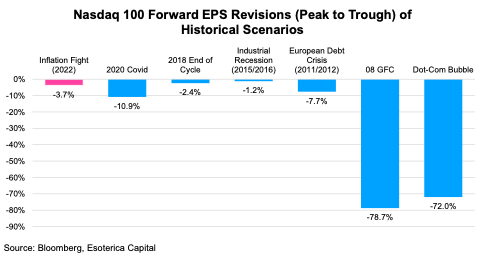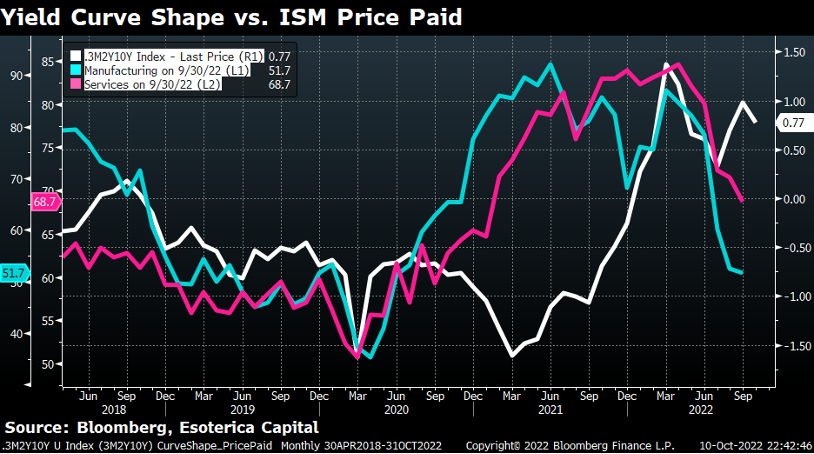Monthly Investor Letter, September 2022
“The end of Fed tightening will come when something breaks, and from where I sit cracks are forming.” -- Scott Minerd, Global CIO of Guggenheim Partners
Cracks Are Forming
It’s only half-joking when growth investors are banging their heads against a wall and begging for a recession these days. The irony behind their longing is that it might take a recession, or something broken, to force the Fed to end this front-loaded hiking campaign from which growth assets suffer the most. Whatever the pain a recession possibly brings could be well offset by loosening financial conditions. That’s the expectation, at least.
This is not the typical cycle-ending hiking play that we are used to, like the most recent experience we had at the end of 2018 (Chart 1). The Fed put its blunt monetary policy tool on the show, which has been aggressively slowing down the demand growth as measured by the inventory/sales ratio and ISM PMI. In normal times, these cracks are bad enough for the Fed to pivot. Not this time around: the elevated CPI print keeps the Fed at bay. Throughout August and September, the message from the Fed is loud and clear: not so early.
Chart 1

Close 

This new dynamic leaves investors with a risky scenario that they haven’t experienced before. What if the Fed’s tolerance for deteriorating fundamentals is much higher than usual? In other words, the negative EPS revisions (more than often a lagging indicator) could hit investors before the Fed loosens up. That alone could amplify the equities’ downside risk even from today’s level.
Chart 2

Close 

To quantify the potential impact, we studied the full magnitude of EPS revisions of QQQ, from peak to trough, during each recession or near-recession scenario since the dot-com bubble (Chart 2). Outside the severe recessions (2008 and the dot-com bubble), the worst revision was 11% during the global pandemic lockdown in 2020. As of October 07, 2022, the current EPS revision from the peak is already 3.7%. It certainly looks scarier when we are in deep recessions. However, the catch is that the Fed could have turned around way before the complete negative revision materialized. It’s not a stretched assumption, in our opinion.
Nike’s Quarter, A Bad Omen
We pick on Nike’s recent quarter as a good case in point that fundamentals have been deteriorating fast. Nike reported its Fiscal Q1 results in late September. The quarter was fine. Small beats on both revenue and EPS, although a slight miss to gross margin. What caught investors off guard was its forward-looking guidance. Blaming the strong dollar, the management now sees sales dollar growth of low-to-mid-single digits for the year, compared to its previous guidance of +6% to 8%. Yes, the dollar was strong, which put one-time pressure on dollar-denominated sales, but could it also be the softening of demand?
What’s more, inventory was high. Nike's inventory in North America increased by 65% in the last quarter versus last year, while the entire company was up 44%. After the supply chain disruptions through the pandemic, Nike decided to place orders early from its Asian vendors; as the shipping glut eased, old and new orders were arriving simultaneously. This is not surprising. Lululemon experienced pretty much the same. The market did not take this development well.
The Fed, Case for Caution?
More prominent voices have joined the growing list that calls the Fed’s aggressive hiking for caution. To be clear, nobody is expecting a near-term “pivot” as being misplaced and abused by financial media lately. The market expects the Fed to be more mindful of unintended consequences after three jumbo 75bps hikes in a row. Financial stability is as important as keeping inflation in check at this juncture.
“We also recognize that liquidity is a little fragile in core markets and so we’re carefully monitoring liquidity conditions in those markets.” -- Lael Brainard, Federal Reserve Vice Chair
We made a case that the Fed was no longer behind the curve. It takes time for the Fed’s tightening actions to impact economic activities and, eventually, prices. We found the curvature of the yield curve (3M2Y10Y butterfly as a proxy) has been very informative regarding whether the Fed has been keeping up with inflation expectations. By this measure, the Fed is tighter than inflation expectations could justify now (Chart 3).
Chart 3

Close 

Esoterica's statements are not an endorsement of any company or a recommendation to buy, sell or hold any security. For full disclosures, click here.




